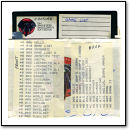30 Years of x86 on PC World
June 17th, 2008 by Benj Edwards Thirty years ago this month, Intel released the 8086 microprocessor, the originator of the now-famous x86 standard and the ultimate progenitor of most modern consumer CPUs.
Thirty years ago this month, Intel released the 8086 microprocessor, the originator of the now-famous x86 standard and the ultimate progenitor of most modern consumer CPUs.
But what, exactly, does all that mean? Well, think of it this way: any assembly language program written as far back as 1978 for the Intel 8086 will run, unmodified, on Intel’s latest Core 2 Extreme released in 2008 — only 180,000 times faster.
The thirty-year tale of x86 began when an Intel engineer named Stephen P. Morse defined the 8086 instruction set (the core group of instructions that define what a microprocessor can do) while working at Intel in the late 1970s. That same instruction set would go on to form the basis of the world’s most popular personal computer architecture. Even the once-insular Macintosh platform, the last mainstream bastion of the non-Intel world, now runs on x86 processors.
 What’s going on here, and how did it get that way?
What’s going on here, and how did it get that way?
PC World recently published a feature I wrote on the anniversary that answers those questions, along with an in-depth interview I conducted with Stephen P. Morse, designer of the 8086 and the original x86 instruction set.
Anyone interested in PC history, or how this standard came to be, should check them out. For better or for worse, x86 is what we’re stuck with, so I feel that it is important for computer users to understand it.
I hope you enjoy the article.






June 20th, 2008 at 7:56 pm
And I’m one of the last PPC Mac holdouts. I figure I’ll get an Intel Mac sometime around 2012, just as I just got a Pismo Powerbook (400mhz G3) that is seven years old 🙂
July 5th, 2008 at 7:58 am
Thank you, it was interesting to read about a man behind the 8086.